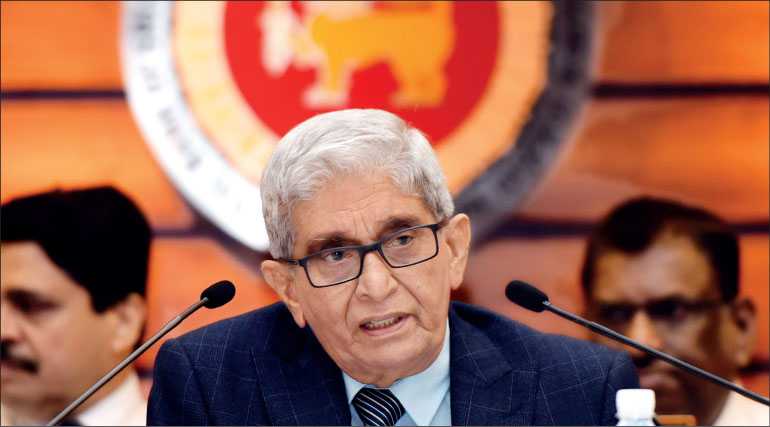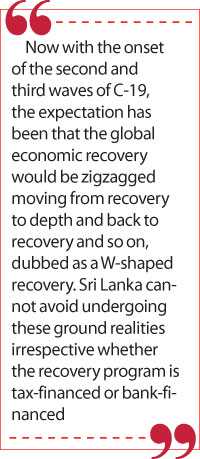Monday Feb 24, 2025
Monday Feb 24, 2025
Monday, 27 July 2020 00:30 - - {{hitsCtrl.values.hits}}

MMTs argue that there is nothing wrong in a central bank producing money for attaining prosperity. Those arguments are sweet music to the politicians who have no foresight of the imminent danger
An enthusiastic reader
An enthusiastic reader of the article in this series last week (available at: http://www.ft.lk/columns/C-19-economic-recovery-Most-probably-it-will-be-a-flattened-U-shaped-one/4-703372) has brought to my notice two propositions for Sri Lanka to attain a quick economic recovery – dubbed as V-shaped recovery – after the present COVID-19, or in short C-19, monster has been fully caged in. 
Sri Lanka could bargain for only a prolonged economic recovery
In the above-mentioned article, it was suggested that Sri Lanka could at most bargain for a prolonged recovery – called a flattened U-shaped recovery – given the disrupted global economic conditions affecting the country and its government’s inability to finance the reconstruction work by using its unutilised budgetary powers called the ‘fiscal space’. Hence, the only option available to it was to finance the recovery program by borrowing from banks.
But now with the onset of the second and third waves of C-19, the expectation has been that the global economic recovery would be zigzagged moving from recovery to depth and back to recovery and so on, dubbed as a W-shaped recovery. Sri Lanka cannot avoid undergoing these ground realities irrespective whether the recovery program is tax-financed or bank-financed.
Complacence of a falling man
I also said that Sri Lanka’s economic performance has been declining from around 2013 and the C-19 induced bad economic fallout was on an already dying patient. But the country’s political leaders on both sides were used to blaming their rivals for the mishap claiming that what they passed on was a well performing economy and it was the rivals who had destroyed it. This practice was equated to a man falling from the 20th floor of a building telling a man at the window of the 10th floor that his position was quite alright and no cause for being worried.
Print money and go for a quick recovery
In this background, the enthusiastic reader has suggested that Sri Lanka could still attain a V-shaped quick recovery by getting the Central Bank to print new money and make it available to businesses and exporters at low interest rates. He had suggested an interest rate of 3% for businesses and 0% for exporters, given the importance of having to earn foreign exchange by the country. The underlying rationale for the Central Bank to print new money is the presumption that such money printing is virtually costless. He has also opined that the projected hard-landing of the economy, as demonstrated by the man falling from the 20th floor of the building, could be softened if appropriate cushions are laid on the floor to facilitate a soft-landing. A hard-landing would have crushed the economy but a soft-landing would have enabled it to escape without injuries.
Both these suggestions are not without precedents.
An economy can avoid a hard-landing through appropriate policies
Making an economy soft-land when it is about to hard-land was exactly what China did in 2010s. When USA threatened to cut its lifeline by imposing restrictions on its exports, China intensified its economic relations with more lucrative South Asian and South East Asian countries and managed to escape even a soft-landing. Hence, through appropriate economic policies, it is always possible for a country to convert an impending hard-landing to a soft-landing. Therefore, as suggested by the enthusiastic reader, Sri Lanka’s policy makers should start strategising right from now to prevent the imminent hard-landing of the economy due to the C-19 menace. It requires the adoption of immediate to short term to medium term economic policies to take the economy out of the slow growth mode and place it on the targeted growth path.
The way out
In this series of articles, I have presented a set of strategies for Sri Lanka to place its economy on a viable growth path. In the case of agriculture, it was proposed that paddy farmers should be given access to new technology enabling them to increase yields and reduce the average cost of production. Exporters should be encouraged to join the global production sharing networks by adopting advanced technologies. Public service should be reformed with capacity improvement via new technologies. The loss-making state-owned enterprises should be converted to efficient production units to free the taxpayers of having to bear the burden. The current consumption-oriented budget should be transformed to an investment oriented one allocating more funds for human capital improvement and technological advancements. These are some strategies that should be adopted to make the imminent hard-landing a soft-landing.
MLCF: Use of Central Bank profits to fund medium to long-term lending
The Central Bank’s offer of a stimulus to the economy had been done in the past by transferring a part of its profits to a fund called the Medium and Long-term Credit Fund or MLCF. The transfer to this fund was done annually after the Bank had ascertained its profits but before transferring the surplus to the government. Hence, in effect, it was a fund created by the government but operated by the Central Bank. Thus, there was no new money printing involved. Moneys in the fund were lent to exporters and other entrepreneurs through participating commercial banks at concessionary interest rates. Commercial banks had lent money to borrowers after selecting them and claimed refinance from the Central Bank. To cover the credit risk, the Central Bank had operated a separate credit guarantee scheme to which the participating banks had to pay an annual premium.
Abandoning the MLCF
MLCF was in vogue in 1970s and 1980s when Sri Lanka’s banks were short of liquidity, interest rates were high due to tight monetary policies, the country’s savings were at a low level and those savings were kept outside the banking system. There are some success stories but many failures. Two factors caused MLCF to have a natural death. First, when the liquidity position in banks improved, there was no necessity for cheap refinancing from the Central Bank. Second, the government very badly needed the Central Bank’s profits to finance its ballooning expenditure programs. As a result, by 2000s, most of the credit schemes got fizzled out.
Central Bank’s dilemma with the new liquidity fund
In the current context, the Central Bank has created a liquidity fund of Rs. 150 billion at the instance of the government to provide short-term working capital to businesses affected by C-19. Of this, Rs. 60 billion is to be provided by the Bank by printing new money but even that amount has been a cause of concern for the Bank. That is because in terms of its existing capital funds, as revealed by the Bank’s top officials, only Rs. 30 billion could be provided without endangering its inflation-targets.
Hence, the balance Rs. 90 billion is to be provided by commercial banks out of their own liquid funds and the Central Bank would support them by providing a credit guarantee to support their lending operations. In my view, this model is the best which the Bank can adopt at the present juncture without compromising its main objective of delivering an inflation-free world to Sri Lankans.
Modern Monetary Theory
Money printing for economic prosperity is being advocated presently by a new school of economics known as Modern Monetary Theorists or MMTs. MMT has a long history but the prominent current advocates are Warren Mosler and L Randall Wray of the University of Missouri – Kansas City, USA and Bill Mitchell of the University of Newcastle in Australia. They base their argument on the concept of a government token known as ‘charta’ through which the government can borrow from the private sector. In modern times, currency notes, Treasury bills or Treasury bonds are examples of chartas. Since the use of the last two add to the government’s debt explicitly and they are governed by Parliamentary control, the issue of currency notes has been the easiest and most convenient charta for borrowing from the people. Hence, modern monetary theory is also called ‘chartalism’.
MMT’s argument: A bigger money packet makes you feel richer
Their main argument is that governments’ printing money and financing budget deficits have a favourable impact on economies because people will get encouraged to work harder due to the feeling that they are now richer than before. It happens in the following way. Suppose that the government prints money and spends on people who now have a higher money income. But they do not have an obligation to pay back such money and even the government’s obligation to pay the value of the money it has issued is just on paper and not in reality.
If the necessity for paying back the value arises, the government can easily meet its obligation just by giving out a new currency note. As a result, when people have a higher money income without a corresponding obligation to pay back, they have higher money on a net basis making them feel richer than before. Economists call this feeling of richness the ‘wealth effect’. This wealth effect will force them to consume more, invest more and work harder. The higher consumption will encourage an increase in supply, while higher investment and hard-work will raise the overall output and employment in the economy.
Thus, money printing and financing of expenditure by the government will push an economy to a higher level of output and employment. So, the secret to economic prosperity is to have a bigger government, run budget deficits, print money and feel people richer than before because they do not have obligations relating to the money they hold.
MMT’s argument: Giving government jobs is building a buffer stock of consumers
MMT also argues that governments should guarantee jobs for the unemployed. Such job guarantees issued by governments, most often at minimum wages, will raise employment, give additional income to the unemployed who would use that income to consume more and encourage production. The increased production will raise output and supply in the market thereby stabilising the prices and killing inflationary pressures. They also argue that these newly employed people serve as a buffer stock of consumers who would automatically stabilise an economy in a recession. Thus, reducing the size of the buffer stock of added consumers will reduce the budget deficits, but it will eat out the booming economy as well. Hence, the way to prosperity is to increase the budget deficits, expand the buffer stock of added consumers and allow the economy to continue its expansion.
Defects of MMT
MMT has therefore offered a dose of chartalism to people who have been frustrated by the failure of economies to give them jobs, incomes and means of enjoying a good life. But it ignores the possibility of creating inflation and the newly printed chartas becoming an obligation of the people due to a reduction in real living of people arising from inflation. It also ignores the possibility of raising prosperity in foreign countries through increased imports, on one side, and creating balance of payments difficulties, on the other. As Singapore’s First Finance Minister Goh Keng Swee has said, financing government budget deficits through printed money is a recipe for economic disaster in an open economy and a country should not run the risk of compromising long-term economic growth by imposing import controls. The present government has resorted to this last strategy.
John Law: The earliest advocate of MMT
There has been an earlier occasion in France where chartalism had misfired. In this case, the Scottish economist John Law who fled to France to avoid a murder trial in the UK got hold of France’s youthful king Louis XV and convinced him that money belonged to the king and therefore the latter could use it for his own purposes. This theory had been presented by Law earlier in a book published in 1705 under the title ‘Money and Trade Considered: With a Proposal for Supplying the Nation with Money’.
The nation he referred to was his own native land Scotland and his proposal was to supply it with a plentiful of money enabling Scotland to promote trade and bring prosperity and wealth to people. The reason he had to come up with this proposal was that the Gold Standard that was in use at that time had failed to produce enough money to facilitate nations to finance the ever-expanding international trade. That is because unless a nation had acquired enough gold it cannot buy goods from other countries and if it is unable to buy goods, it fixes a limitation on other countries to sell their products to that country. Thus, trade is impeded and through that impediment, wealth and employment creations are also impeded.
John Law: Money belongs to the king
John Law argued that money in a society serving only as an exchange token to buy goods and services is a public good and the king has the right to manage and control that public good in public interest. If anyone hoards money when it comes to his hand without spending on goods and services, Law termed it as a criminal activity. Thus, the king has the right to prevent it by using all means at his disposal including the replacement of metallic currency with paper currency. Hence, John Law was the father of paper currency in modern times. Money or any other property becomes the property of people only if they use them for the benefit of the community. Hence, if people hoard metallic currency without spending it on goods and services, or in other words do not create a demand for same, the king should replace them with paper currency which cannot be hoarded for a significant period of time.
Following MMT to bankruptcy by France
Convinced by Law’s seemingly practicable arguments, King Louis XV allowed him to establish a private bank called Banque Generale Privee which later became Banque Royale in 1717 with three quarters of capital consisting of government bills and government accepted notes. The bank accepted deposits in coins and issued paper money called Ecus on the strength of those coins and the government notes. Hence, it virtually became the central bank of France. When France’s economy was stagnant and its national debt was unmanageably high at 3 billion livres, the currency of France at that time, against an annual government revenue of some 145 million livres, Law emerged as the savior. He suggested that his bank will buy back French national debt using the proceeds of the IPO, the rest of the debt to be assigned to shares in ventures and new circulation currency called Ecus to be issued by the Bank in bigger volumes. That money will promote trade, increase employment and economic growth pushing France out of economic bankruptcy. Hence, it amounted to using loose monetary policy to rescue France as is being argued by many today. But the production of too much paper money destroyed the French economy and in 1720, the French government had to accept failure and reverse its policy. But today, the newly born MMTs argue that there is nothing wrong in a central bank producing money for attaining prosperity. Those arguments are sweet music to the politicians who have no foresight of the imminent danger.
If people are to learn from past mistakes, a cautious approach is needed when using newly printed money for attaining a quick V-shaped recovery.
(The writer, a former Deputy Governor of the Central Bank of Sri Lanka, can be reached at [email protected].)
Discover Kapruka, the leading online shopping platform in Sri Lanka, where you can conveniently send Gifts and Flowers to your loved ones for any event including Valentine ’s Day. Explore a wide range of popular Shopping Categories on Kapruka, including Toys, Groceries, Electronics, Birthday Cakes, Fruits, Chocolates, Flower Bouquets, Clothing, Watches, Lingerie, Gift Sets and Jewellery. Also if you’re interested in selling with Kapruka, Partner Central by Kapruka is the best solution to start with. Moreover, through Kapruka Global Shop, you can also enjoy the convenience of purchasing products from renowned platforms like Amazon and eBay and have them delivered to Sri Lanka.
Discover Kapruka, the leading online shopping platform in Sri Lanka, where you can conveniently send Gifts and Flowers to your loved ones for any event including Valentine ’s Day. Explore a wide range of popular Shopping Categories on Kapruka, including Toys, Groceries, Electronics, Birthday Cakes, Fruits, Chocolates, Flower Bouquets, Clothing, Watches, Lingerie, Gift Sets and Jewellery. Also if you’re interested in selling with Kapruka, Partner Central by Kapruka is the best solution to start with. Moreover, through Kapruka Global Shop, you can also enjoy the convenience of purchasing products from renowned platforms like Amazon and eBay and have them delivered to Sri Lanka.